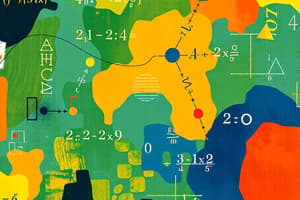Podcast
Questions and Answers
What is the definition of algebra?
What is the definition of algebra?
A branch of mathematics dealing with symbols and the rules for manipulating those symbols; represents numbers and quantities in formulas and equations.
Which of the following is a quadratic equation?
Which of the following is a quadratic equation?
- y = 3x + 2
- x^2 - 4x + 4 = 0 (correct)
- 2x + 3 = 7
- y = 5
A function relates a set of inputs to a set of permissible ______.
A function relates a set of inputs to a set of permissible ______.
outputs
What is the definition of a polynomial function?
What is the definition of a polynomial function?
Inequalities can only be represented graphically.
Inequalities can only be represented graphically.
What does slope represent in a graph?
What does slope represent in a graph?
Which method can be used for factoring the expression $x^2 - 9$?
Which method can be used for factoring the expression $x^2 - 9$?
Flashcards are hidden until you start studying
Study Notes
Algebra
-
Definition: A branch of mathematics dealing with symbols and the rules for manipulating those symbols; represents numbers and quantities in formulas and equations.
-
Key Concepts:
- Variables: Symbols (often letters) used to represent unknown values (e.g., x, y).
- Constants: Fixed values that do not change (e.g., 5, -3).
- Expressions: Combinations of variables and constants using mathematical operations (e.g., 2x + 3).
- Equations: A statement that two expressions are equal (e.g., 2x + 3 = 7).
-
Operations:
- Addition, subtraction, multiplication, division.
- Order of operations (PEMDAS/BODMAS): Parentheses, Exponents, Multiplication and Division (from left to right), Addition and Subtraction (from left to right).
-
Solving Equations:
- Isolate the variable: Use inverse operations to solve for the unknown (e.g., if 2x + 3 = 7, subtract 3 and then divide by 2).
- Linear equations: Equations of the first degree, such as y = mx + b, where m is the slope and b is the y-intercept.
- Quadratic equations: Equations of the second degree in the form ax^2 + bx + c = 0; solutions can be found using factoring, completing the square, or the quadratic formula.
-
Functions:
- Definition: A relation between a set of inputs and a set of permissible outputs, typically expressed as f(x).
- Types of functions:
- Linear: Graphs as straight lines; represented in the form f(x) = mx + b.
- Quadratic: Graphs as parabolas; represented in the form f(x) = ax^2 + bx + c.
- Polynomial: Expressions that involve variables raised to whole number powers.
- Exponential: Functions of the form f(x) = ab^x, where b is a positive constant.
-
Inequalities:
- Statements about the relative size or order of two values; expressed using symbols like <, >, ≤, ≥.
- Solutions can be represented on a number line or in interval notation.
-
Graphing:
- Coordinate System: A plane defined by x (horizontal) and y (vertical) axes.
- Plotting Points: Represent coordinates (x, y) on the graph.
- Slope: Measure of steepness of the line; calculated as rise over run (change in y over change in x).
-
Factoring:
- Breaking down expressions into products of simpler expressions (e.g., factoring x^2 - 9 into (x + 3)(x - 3)).
- Common methods include grouping, using the distributive property, and applying special products (e.g., difference of squares).
-
Applications:
- Used in problem-solving across disciplines, including science, economics, engineering, and statistics.
- Fundamental for understanding higher-level mathematics, such as calculus and linear algebra.
Algebra
-
Definition: Algebra is a branch of mathematics that deals with symbols and the rules for manipulating those symbols. It uses symbols called variables to represent unknown values and constants to represent fixed values.
-
Key Concepts:
- Variables: Letters that represent unknown values.
- Constants: Numbers that have fixed values.
- Expressions: Combinations of variables and constants using math operations.
- Equations: Statements where two expressions are equal.
- Operations: Addition, subtraction, multiplication, and division.
- Order of Operations (PEMDAS/BODMAS): Parentheses, Exponents, Multiplication and Division (from left to right), Addition and Subtraction (from left to right).
Solving Equations
- Isolate the Variable: Use inverse operations to get the variable by itself. For example, if 2x + 3 = 7, subtract 3 from both sides, then divide by 2 to find x.
- Linear Equations: Equations in the form y = mx + b, where m is the slope and b is the y-intercept. Their graphs are straight lines.
- Quadratic Equations: Equations in the form ax^2 + bx + c = 0. Solutions can be found by factoring, completing the square, or using the quadratic formula.
Functions
-
Definition: A relation between a set of inputs and their corresponding outputs.
-
Examples:
- Linear Functions: Graph as straight lines, represented by f(x) = mx + b.
- Quadratic Functions: Graph as parabolas, represented by f(x) = ax^2 + bx + c.
- Polynomial Functions: Expressions that involve variables raised to whole number powers.
- Exponential Functions: Functions of the form f(x) = ab^x, where b is a positive constant.
Inequalities
- Definition: Statements about the relative size or order of two values.
- Symbols: <, >, ≤, ≥.
- Solutions: Can be represented on a number line or using interval notation.
Graphing
- Coordinate System: Uses x (horizontal) and y (vertical) axes to represent a plane.
- Plotting Points: (x, y) coordinates are used to plot points on the graph.
- Slope: The steepness of a line, calculated by rise over run (change in y over change in x).
Factoring
- Definition: Breaking down expressions into simpler expressions (products).
- Methods:
- Grouping: Similar terms are grouped together to factor.
- Distributive Property: Used to expand expressions.
- Special Products: Formulas for differences of squares or sums of cubes.
Applications
- Problem Solving: Used in various fields like science, economics, engineering, and statistics.
- Foundation for Higher-Level Math: Essential for understanding calculus and linear algebra.
Studying That Suits You
Use AI to generate personalized quizzes and flashcards to suit your learning preferences.




